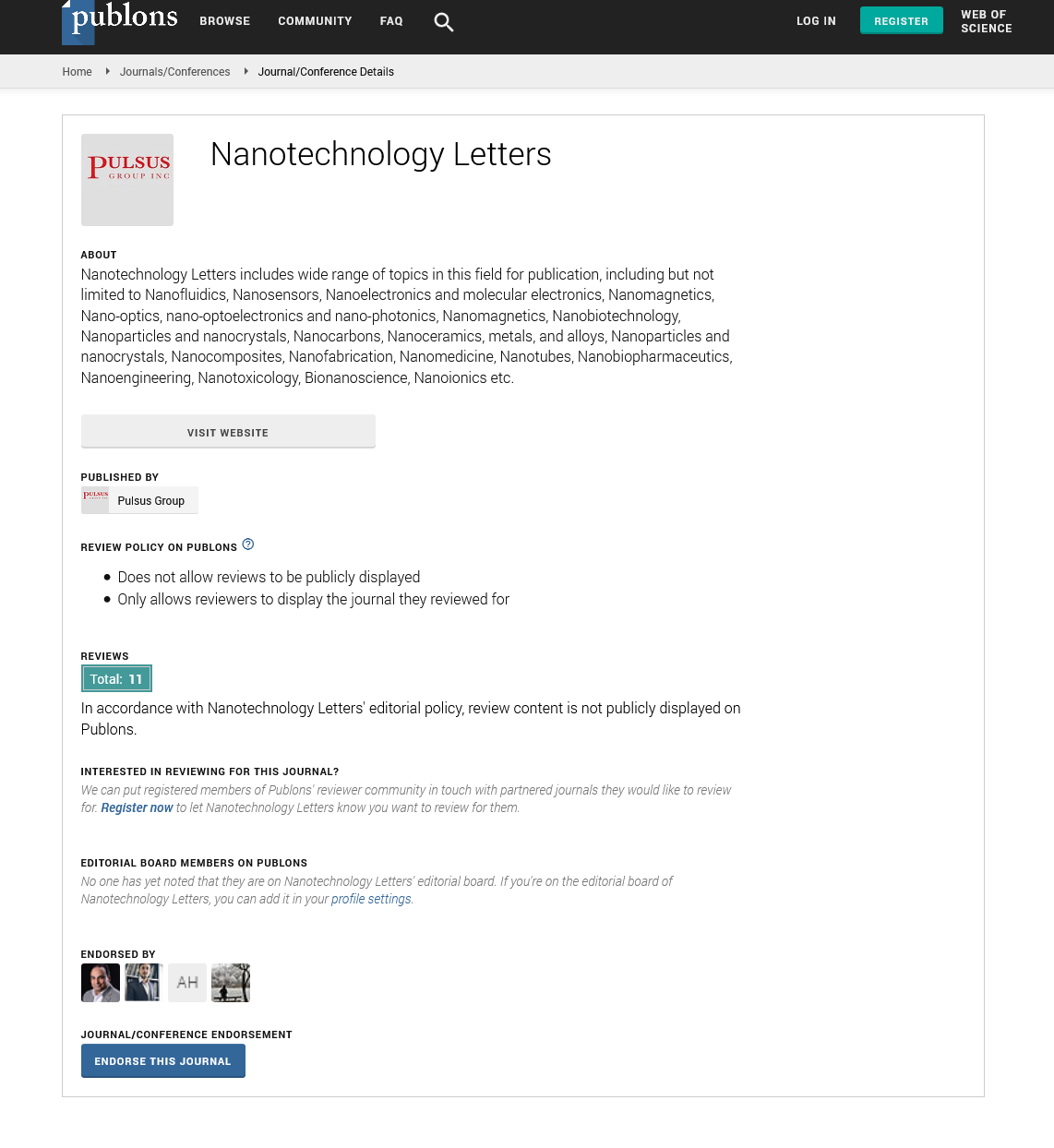Nanoscience, nanoelectronics, and nanophotonics
Received: 01-Mar-2022, Manuscript No. pulnl-22-4755; Editor assigned: 05-Mar-2022, Pre QC No. pulnl-22-4755(PQ); Reviewed: 19-Mar-2022 QC No. pulnl-22-4755(Q); Revised: 24-Mar-2022, Manuscript No. pulnl-22-4755(R); Published: 27-Mar-2022, DOI: 10.37532. pulnl-22.7(2)1-2.
Citation: Hoffman A. Nanoscience, nanoelectronics and nanophotonics. Nanotechnol Lett. 2022; 7(2):1-2.
This open-access article is distributed under the terms of the Creative Commons Attribution Non-Commercial License (CC BY-NC) (http://creativecommons.org/licenses/by-nc/4.0/), which permits reuse, distribution and reproduction of the article, provided that the original work is properly cited and the reuse is restricted to noncommercial purposes. For commercial reuse, contact reprints@pulsus.com
Abstract
Nanoscience and technology is a discipline of science that studies and manipulates matter at the atomic, molecular, and supramolecular levels (the nanometre scale). Nanoscience is the study of extremely small structures and materials, as well as their distinctive and desirable features. It is the study and application of small items that can be used in a range of fields such as research, development, and material science. Individual atoms can be controlled by these particles. Nanotechnology has significant promise for solving a wide range of problems in science, essentialism, material science, contingency, and therapeutic disciplines.
Opinion
The word nanoelectronics refers to the application of nanotechnology to electronic components. The size of these components is usually only a few nanometers. Electrical components become smaller as manufacturing becomes more difficult. Nanoelectronics refers to a variety of materials and devices that are so small that physical processes can change their properties on a nanoscale. Interatomic interactions and quantum mechanical properties have a big impact on how these devices perform. Nanophotonics, also known as nano-optics, is a branch of nanotechnology that studies the behaviour of light at nanoscales and how nanometer-sized things interact with it. Electrical engineering, optics, and optical engineering are all part of nanophotonics, which is a sub-discipline of nanotechnology. To regulate the parameters of quantum emitters and maximise their effectiveness, nanophotonic devices are required. Nanobiotechnology refers to the intersection of biology and nanotechnology. This field aids in the integration of scientific study with a variety of nanotechnology fields. Nanobiology improves ideas by considering the nanoscale, nanodevices, and nanoparticle phenomena seen in nanotech research. "Nanosafety" refers to all of the issues surrounding nanotechnology's protection. Nanotechnology is still considered a novel technology, despite the fact that it has been growing for nearly two decades, and the health impacts of nanoparticles have not been fully researched. Nanosized materials have different physicochemical properties than their original counterparts (thereby changing their reactivity in biological systems). It begs the question of whether traditional methodologies for assessing NMs' negative impacts are still valid. Nanomaterials are extremely small particles with diameters ranging from 1 to 100 nanometers. Biological approaches are used to create green nanomaterials or nanoparticles. Natural resources such as plants, microbes, and organic polymers such as carbohydrates, proteins, and lipids contribute in the production of green nanoparticles.
Green nanoparticles offer a novel way to remove toxins from bodies of water. For wastewater treatment, green nanoparticles offer a cost-effective, simple, and ecologically beneficial choice. Nanotechnology is a cutting-edge science that has the ability to address the existing water treatment difficulties. It has the potential to add new dimensions to current water treatment procedures by permitting the most efficient use of unusual water resources. Nanotechnology is used in water treatment for three main purposes: remediation and purification (by removing all or part of the contaminants), pollution monitoring (by using pollutant-specific nanosensors and detectors), and pollution prevention (by using pollutant-specific nanosensors and detectors). Nanoengineering is a branch of engineering that focuses on the research, development, and refining of materials on a very small scale. It's a practical application of nanoscience, comparable to how mechanical engineering employs physics principles. The study of nanoparticles and their interactions with the objective of generating useful materials, systems, devices, and structures is known as nanoengineering. Nanoengineering is a technique that can be used in a variety of fields, including electronics, energy, medicine, and biotechnology. It isn't a brand-new field of study. The work of a nanoengineer can be very varied, however it usually revolves around the development of nanomaterials. Nanocomposites, quantum dots, and carbon nanotubes are only a few examples. Nanotechnology is a branch of science that involves manipulating the molecular structure of materials in order to alter their inherent properties and create new ones with revolutionary applications. This is true of graphene, a modified carbon nanoparticle that is harder than steel, lighter than aluminium, and nearly transparent, and is employed in electronics, energy, healthcare, and defence. Nanotechnology is a burgeoning field of study and development all around the world, and nanoparticles may already be found in a variety of items such as sunscreens, cosmetics, fabrics, and sports equipment. Drug delivery, biosensors, and other therapeutic uses are all made possible by nanotechnology.
Nanotechnology has the ability to significantly improve the quality of our air, water, and energy generation while also having significant environmental implications. Environmental nanotechnology is the use of nanotechnology techniques to reduce or prevent environmental degradation. By proposing solutions for removing current contaminants, nanotechnology has the potential to have a positive impact on the environment. Environmental nanotechnology holds a lot of promise for bettering our planet's quality of life. Nanotechnological materials, methods, and applications are predicted to make major contributions to environmental and climate protection by saving raw resources, energy, and water, as well as reducing greenhouse gas emissions and hazardous waste. As a result, there are some environmental benefits and long-term consequences of employing nanoparticles.
On the other side, nanotechnology is now playing a little role in environmental protection, whether through research or development. Carbon Nanotubes (CNTs) are cylinder-shaped molecules produced from rolled-up single-layer carbon atom sheets (graphene). Single-Walled Carbon Nanotubes (SWCNT) and Multi-Walled Carbon Nanotubes (MWCN) are the two forms of carbon nanotubes. Multi-Walled Nanotubes (MWCN) are made up of many concentrically linked nanotubes with a diameter more than 100 nm. SWCNTs have a diameter of less than one nanometer. They might be as small as a few micrometres or as large as a few centimetres. Carbon nanotubes are one of the most durable materials known to man, with unique structural and electrical qualities that make them suitable for a wide range of uses.






